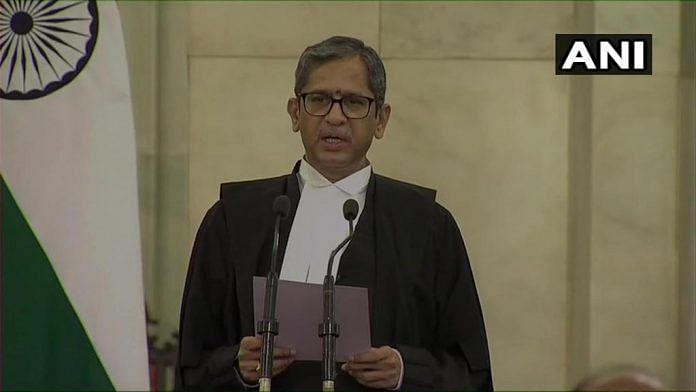New Delhi: The projected statistics that pendency in Indian courts has reached 45 million cases, which is perceived as the inability of the Indian judiciary to cope with the caseload, is an “overstatement” and an “uncharitable analysis” and one of the factors contributing to judicial delays is “luxurious litigation”, Chief Justice of India N V Ramana said on Saturday.
He said conflicts are unavoidable in any society for various reasons, including political, economic, social, cultural and religious, and there is a need to develop mechanisms for conflict resolution and referred to the Mahabharata, providing an example of an early attempt at mediation as a conflict resolution tool.
Mediation is deeply embedded into the Indian ethos and was prevalent before the British adversarial system in India, various forms of mediation were being practised as a method of dispute resolution, he said.
Delivering his keynote address at the India-Singapore Mediation Summit “Making Mediation mainstream: Reflections from India and Singapore”, Justice Ramana said many Asian countries have a long and rich tradition of collaborative and amicable settlement of disputes.
“The great Indian epic, the Mahabharata, actually provides an example of an early attempt at mediation as a conflict resolution tool, where Lord Krishna attempted to mediate the dispute between the Pandavas and Kauravas. It may be worthwhile to recall that the failure of mediation led to disastrous consequences,” he said.
He also shared a funny anecdote capturing the attitude of judges in this adversarial system, when a judge was sipping his early morning coffee, flipping through the newspaper and his granddaughter approached him and said, “Grandpa, my elder sister has taken away my toy.” The judge’s immediate response was “Do you have any evidence?”
“Mediation, as a concept, is deeply embedded into the Indian ethos. Long before the arrival of the British adversarial system in India, various forms of mediation were being practised as a method of dispute resolution. Disputes were often resolved by the chieftains or elders of the community
“However, the establishment of the British courts system, in 1775, marked the erosion of community-based indigenous dispute resolution mechanisms in India. The British judicial system has ultimately become the framework, with appropriate modifications, for the current judicial system in India,” he said.
He said there are a few contributing factors that have revived the Alternate Dispute Resolution (ADR) mechanisms in India and one of them is related to judicial delays.
“The often-quoted statistic that ‘pendency’ in Indian courts has reached 45 million cases, which is perceived as the inability of the Indian judiciary to cope with the caseload. This is an overstatement and an uncharitable analysis.
“The term pendency is used to refer to all cases which have not yet been disposed of, without any reference to how long the case has spent in the judicial system. This would mean that a case which was filed yesterday gets added to the pendency statistics. This is, therefore, not a useful indicator of how well, or poorly, a system is doing,” Justice Ramana said.
Admitting that the issue of judicial delays is a complex problem, not just in India, he said several factors contribute towards such a situation.
One of them is an Indian phenomenon called – ‘luxurious litigation’, he said. I
“It is a specific type of litigation wherein parties with resources attempt to frustrate the judicial process and delay it by filing numerous proceedings across the judicial system. Undeniably, the prevailing pandemic has also contributed to our woes,” the CJI said.
“Judges in India, particularly in the constitutional courts, often burn the midnight oil to meet their judicial and administrative case load,” he said, adding that the second factor contributing to the growth of ADR relates to the increased access to justice here.
The CJI said nearly 70 per cent of the population are eligible for benefits under various schemes of legal service authorities.
“ADR mechanisms, particularly mediation and conciliation, can reduce pendency, save resources and time, and allow litigants a degree of control over the process and outcome of their dispute resolution process…
“Apart from enhancing and clarifying the law as to mediation, the Supreme Court of India also made an active effort on the administrative side to improve the mediation landscape in India,” he said and added that there are nearly 43,000 mediation centres here and since 2005, nearly 3.22 million cases have been referred and nearly 1 million cases have been settled by mediation up to March.
Justice Ramana asserted that gven the growing scope of mediation, it is time for India to enter mission mode.
To popularise mediation as a cheaper and faster dispute resolution mechanism, a movement needs to be launched, he said.
“Prescribing mediation as a mandatory first step for resolution of every allowable dispute will go a long way in promoting mediation. Perhaps, an omnibus law in this regard is needed to fill the vacuum, he said.
Justice Ramana stressed on the need for mediators to undergo training sessions to keep themselves updated as their role has now evolved from that of a passive facilitator to a role involving advisory participation.
Chief Justice of Singapore Sundaresh Menon also delivered his keynote address at the event and congratulated Justice Ramana on his appointment as the CJI and said he looks forward to working on various initiatives taken by the courts. – PTI
Also read: Is India made of porcelain? Question CJI Ramana should ask Modi govt at next sedition hearing



